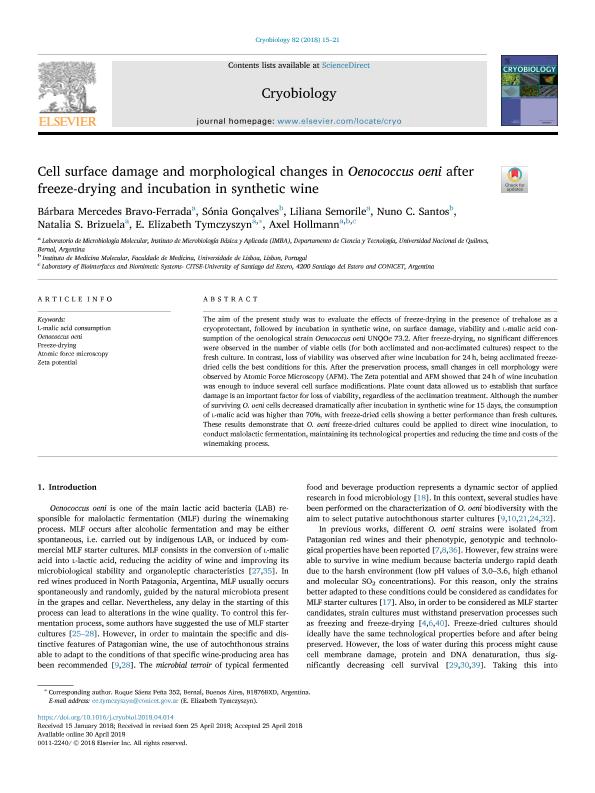Mostrar el registro sencillo del ítem
dc.contributor.author
Bravo Ferrada, Barbara Mercedes

dc.contributor.author
Gonçalves, Sónia
dc.contributor.author
Semorile, Liliana
dc.contributor.author
Santos, Nuno C.
dc.contributor.author
Brizuela, Natalia Soledad

dc.contributor.author
Tymczyszyn, Emma Elizabeth

dc.contributor.author
Hollmann, Axel

dc.date.available
2020-01-16T19:10:41Z
dc.date.issued
2018-06
dc.identifier.citation
Bravo Ferrada, Barbara Mercedes; Gonçalves, Sónia; Semorile, Liliana; Santos, Nuno C.; Brizuela, Natalia Soledad; et al.; Cell surface damage and morphological changes in Oenococcus oeni after freeze-drying and incubation in synthetic wine; Academic Press Inc Elsevier Science; Cryobiology; 82; 6-2018; 15-21
dc.identifier.issn
0011-2240
dc.identifier.uri
http://hdl.handle.net/11336/94936
dc.description.abstract
The aim of the present study was to evaluate the effects of freeze-drying in the presence of trehalose as a cryoprotectant, followed by incubation in synthetic wine, on surface damage, viability and l-malic acid consumption of the oenological strain Oenococcus oeni UNQOe 73.2. After freeze-drying, no significant differences were observed in the number of viable cells (for both acclimated and non-acclimated cultures) respect to the fresh culture. In contrast, loss of viability was observed after wine incubation for 24 h, being acclimated freeze-dried cells the best conditions for this. After the preservation process, small changes in cell morphology were observed by Atomic Force Microscopy (AFM). The Zeta potential and AFM showed that 24 h of wine incubation was enough to induce several cell surface modifications. Plate count data allowed us to establish that surface damage is an important factor for loss of viability, regardless of the acclimation treatment. Although the number of surviving O. oeni cells decreased dramatically after incubation in synthetic wine for 15 days, the consumption of l-malic acid was higher than 70%, with freeze-dried cells showing a better performance than fresh cultures. These results demonstrate that O. oeni freeze-dried cultures could be applied to direct wine inoculation, to conduct malolactic fermentation, maintaining its technological properties and reducing the time and costs of the winemaking process.
dc.format
application/pdf
dc.language.iso
eng
dc.publisher
Academic Press Inc Elsevier Science

dc.rights
info:eu-repo/semantics/openAccess
dc.rights.uri
https://creativecommons.org/licenses/by-nc-sa/2.5/ar/
dc.subject
ATOMIC FORCE MICROSCOPY
dc.subject
FREEZE-DRYING
dc.subject
L-MALIC ACID CONSUMPTION
dc.subject
OENOCOCCUS OENI
dc.subject
ZETA POTENTIAL
dc.subject.classification
Alimentos y Bebidas

dc.subject.classification
Otras Ingenierías y Tecnologías

dc.subject.classification
INGENIERÍAS Y TECNOLOGÍAS

dc.subject.classification
Alimentos y Bebidas

dc.subject.classification
Otras Ingenierías y Tecnologías

dc.subject.classification
INGENIERÍAS Y TECNOLOGÍAS

dc.title
Cell surface damage and morphological changes in Oenococcus oeni after freeze-drying and incubation in synthetic wine
dc.type
info:eu-repo/semantics/article
dc.type
info:ar-repo/semantics/artículo
dc.type
info:eu-repo/semantics/publishedVersion
dc.date.updated
2019-12-20T22:52:36Z
dc.journal.volume
82
dc.journal.pagination
15-21
dc.journal.pais
Países Bajos

dc.journal.ciudad
Amsterdam
dc.description.fil
Fil: Bravo Ferrada, Barbara Mercedes. Universidad Nacional de Quilmes. Departamento de Ciencia y Tecnología. Laboratorio de Microbiología Molecular; Argentina. Consejo Nacional de Investigaciones Científicas y Técnicas; Argentina
dc.description.fil
Fil: Gonçalves, Sónia. Universidade de Lisboa; Portugal
dc.description.fil
Fil: Semorile, Liliana. Universidad Nacional de Quilmes. Departamento de Ciencia y Tecnología. Laboratorio de Microbiología Molecular; Argentina
dc.description.fil
Fil: Santos, Nuno C.. Universidade de Lisboa; Portugal
dc.description.fil
Fil: Brizuela, Natalia Soledad. Consejo Nacional de Investigaciones Científicas y Técnicas; Argentina. Universidad Nacional de Quilmes. Departamento de Ciencia y Tecnología. Laboratorio de Microbiología Molecular; Argentina
dc.description.fil
Fil: Tymczyszyn, Emma Elizabeth. Consejo Nacional de Investigaciones Científicas y Técnicas; Argentina. Universidad Nacional de Quilmes. Departamento de Ciencia y Tecnología. Laboratorio de Microbiología Molecular; Argentina
dc.description.fil
Fil: Hollmann, Axel. Consejo Nacional de Investigaciones Científicas y Técnicas. Centro de Investigaciones y Transferencia de Santiago del Estero. Universidad Nacional de Santiago del Estero. Centro de Investigaciones y Transferencia de Santiago del Estero; Argentina. Universidad Nacional de Quilmes. Departamento de Ciencia y Tecnología. Laboratorio de Microbiología Molecular; Argentina. Universidade de Lisboa; Portugal
dc.journal.title
Cryobiology

dc.relation.alternativeid
info:eu-repo/semantics/altIdentifier/url/https://www.sciencedirect.com/science/article/pii/S0011224018300178
dc.relation.alternativeid
info:eu-repo/semantics/altIdentifier/doi/http://dx.doi.org/10.1016/j.cryobiol.2018.04.014
Archivos asociados
